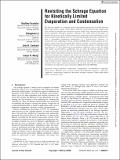| dc.contributor.author | Vaartstra, Geoffrey | |
| dc.contributor.author | Lu, Zhengmao | |
| dc.contributor.author | Lienhard, John H | |
| dc.contributor.author | Wang, Evelyn N. | |
| dc.date.accessioned | 2022-08-19T14:38:03Z | |
| dc.date.available | 2022-08-19T14:38:03Z | |
| dc.date.issued | 2022-05-24 | |
| dc.identifier.issn | 0022-1481 | |
| dc.identifier.issn | 1528-8943 | |
| dc.identifier.uri | https://hdl.handle.net/1721.1/144369 | |
| dc.description.abstract | <jats:title>Abstract</jats:title>
<jats:p>The Schrage equation is commonly used in thermofluid engineering to model high-rate liquid–vapor phase change of pure fluids. Although shortcomings of this simple model were pointed out decades ago and more rigorous models have emerged from the kinetic theory community, Schrage's equation continues to be widely used. In this paper, we quantify the accuracy of the Schrage equation for evaporation and condensation of monatomic and polyatomic fluids at the low to moderately high flux operating conditions relevant to thermofluid engineering applications. As a high-accuracy reference, we numerically solve a Bhatnagar, Gross, and Krook (BGK)-like a model equation for polyatomic vapors that have previously been shown to produce accurate solutions to the Boltzmann transport equation. We observe that the Schrage equation overpredicts heat/mass fluxes by ∼15% for fluids with accommodation coefficients close to unity. For fluids with smaller accommodation coefficients, such as water, the Schrage equation yields more accurate flux estimates. We find that the Mott-Smith-like moment methods developed for liquid–vapor phase change are much more accurate than the Schrage equation, achieving heat/mass flux estimates that deviate by less than 1% (evaporation) and 4% (condensation) from the reference solution. In light of these results, we recommend using the moment method equations instead of the Schrage equation. We also provide tables with our high-accuracy numerical data for evaporation of any fluid and condensation of saturated water vapor, engineering equations fit our data, and code for moment method calculations of evaporation and condensation.</jats:p> | en_US |
| dc.description.sponsorship | Air Force Office of Scientific Research (AFOSR) | en_US |
| dc.publisher | ASME International | en_US |
| dc.relation.isversionof | 10.1115/1.4054382 | en_US |
| dc.rights | Article is made available in accordance with the publisher's policy and may be subject to US copyright law. Please refer to the publisher's site for terms of use. | en_US |
| dc.source | ASME | en_US |
| dc.title | Revisiting the Schrage Equation for Kinetically Limited Evaporation and Condensation | en_US |
| dc.type | Article | en_US |
| dc.identifier.citation | Vaartstra, Geoffrey, Lu, Zhengmao, Lienhard, John H. and Wang, Evelyn N. 2022. "Revisiting the Schrage Equation for Kinetically Limited Evaporation and Condensation." Journal of Heat Transfer, 144 (8). | |
| dc.contributor.department | Massachusetts Institute of Technology. Department of Mechanical Engineering | |
| dc.contributor.department | Massachusetts Institute of Technology. Department of Materials Science and Engineering | |
| dc.relation.journal | Journal of Heat Transfer | en_US |
| dc.eprint.version | Final published version | en_US |
| dc.type.uri | http://purl.org/eprint/type/JournalArticle | en_US |
| eprint.status | http://purl.org/eprint/status/PeerReviewed | en_US |
| dc.identifier.doi | https://doi.org/10.1115/1.4054382 | |
| dspace.date.submission | 2022-08-17T14:48:25Z | |
| mit.journal.volume | 144 | en_US |
| mit.journal.issue | 8 | en_US |
| mit.license | PUBLISHER_POLICY | |
| mit.metadata.status | Authority Work and Publication Information Needed | en_US |
